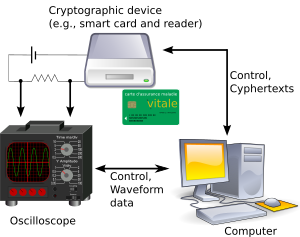
Back Anàlisi de potència Catalan تحلیل توان Persian Analyse de consommation French Analisi di potenza Italian 単純電力解析 Japanese 전력 분석 Korean Galios analizės ataka Lithuanian Атака по энергопотреблению Russian Güç analizi Turkish 能量分析 Chinese
This article has multiple issues. Please help improve it or discuss these issues on the talk page. (Learn how and when to remove these template messages)
|


Power analysis is a form of side channel attack in which the attacker studies the power consumption of a cryptographic hardware device. These attacks rely on basic physical properties of the device: semiconductor devices are governed by the laws of physics, which dictate that changes in voltages within the device require very small movements of electric charges (currents). By measuring those currents, it is possible to learn a small amount of information about the data being manipulated.
Simple power analysis (SPA) involves visually interpreting power traces, or graphs of electrical activity over time. Differential power analysis (DPA) is a more advanced form of power analysis, which can allow an attacker to compute the intermediate values within cryptographic computations through statistical analysis of data collected from multiple cryptographic operations. SPA and DPA were introduced to the open cryptography community in 1998 by Paul Kocher, Joshua Jaffe and Benjamin Jun.[1]
- ^ P. Kocher, J. Jaffe, B. Jun, Differential Power Analysis, technical report, 1998; later published in Advances in Cryptology – Crypto 99 Proceedings, Lecture Notes in Computer Science Vol. 1666, M. Wiener, ed., Springer-Verlag, 1999.